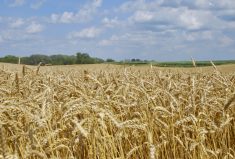Strengths
Russia is blessed with many advantages that strengthen its position as a wheat exporter:
- Russian wheat production is in close proximity to Egypt and Turkey — two of the world’s largest wheat importing markets.
- There is ample arable land — Russia possesses almost 10 per cent of the world’s arable land (122 m ha).
- A large proportion of Russia’s wheat production comes from regions adjacent to several Black Sea ports.
- Grain land freight costs in Russia are low, with most grain transported by truck over short-haul distances.
- Russian grain production is increasingly dominated by large, vertically integrated agro-holdings using state-of-the-art agricultural production techniques and equipment to generate efficient production of high-quality grain.
- A range of government programs, including subsidies on inputs and interest rates, supports grain production in Russia.
- Increased upgrade of, and additional investment in, grain storage and port infrastructure in Russia will accommodate larger crops.
- Russian ports are a mixture of deep-water ports, which can load panamax and handymax vessels for distant markets, and shallow-water ports on the Sea of Azov, which can load smaller coasters to economically ship small parcels to closer markets in the Mediterranean. These shallower ports also give buyers the ability to target specific quality wheat in smaller volumes.
- Up-country storage in Russia is a usable mix of public elevators and on-farm storage.
- Compared with the EU, Australia and North America, Russia has relatively low agricultural land values and a low cost of grain production.
- Medium-protein hard wheat produced in Russia is ideally suited to Middle Eastern flat breads, creating a useful synergy with the country’s proximity to these markets.
- The recent weakness in the ruble ensures FOB grain prices make grain production relatively profitable in Russia.
Read Also

Building a farm legacy that outlasts you
A farm’s legacy isn’t just about the land; it’s also about the values and the impact that continue long after the current owner has stepped away.
Weaknesses
Despite its strengths, there are weaknesses in Russia’s grains industry:
- The Black Sea is Russia’s only viable outlet for exporting large volumes of grain. Any effort to export wheat produced in Siberia means a 4,800 km journey west to the Black Sea or the same distance east to Vladivostok. Grain produced away from the Black Sea is therefore steeply discounted in view of the costs involved in bringing it to port.
- Russian wheat has a relatively poor reputation for producing Western-style breads and Asian noodles, so there is little chance of displacing DNS, CWRS, APH and even HRW in premium Asian markets.
- Since Russia historically gives priority to the availability of affordable food for its citizens, it is unable to use stability of supply as a selling point. Countries with delicately balanced food security will likely be reticent to base their wheat importation requirements on unstable Russian supply.
- Russia’s wheat customers tend to be some of the world’s most price-driven markets, creating few avenues for the extraction of premiums for quality.
- Many small-to-medium-size farms in Russia are forced sellers of their grain. Inadequate and inferior on-farm grain storage, price inflation and inability to access price risk management tools force many farmers to sell at or near harvest.
(Above analysis compiled from AEGIC report)
















